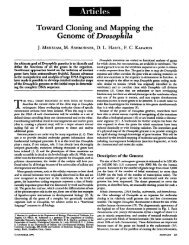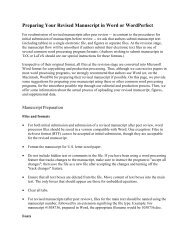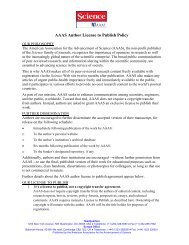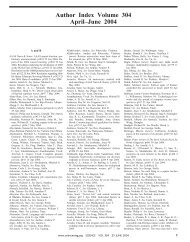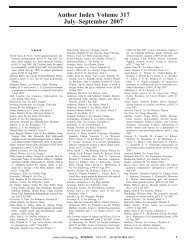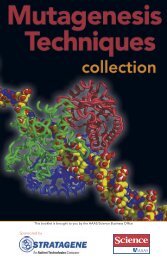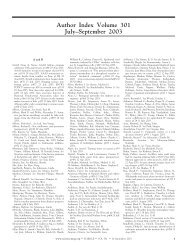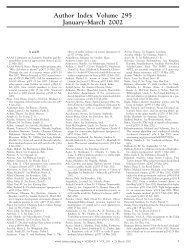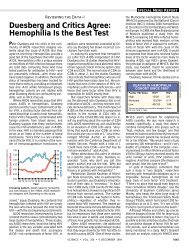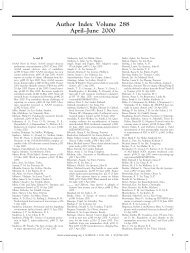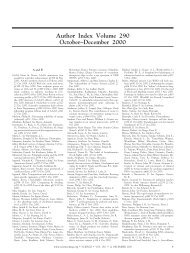Chinese Academy of Sciences (PDF) - low res version
Chinese Academy of Sciences (PDF) - low res version
Chinese Academy of Sciences (PDF) - low res version
Create successful ePaper yourself
Turn your PDF publications into a flip-book with our unique Google optimized e-Paper software.
CREDITS: (1, 2 AND 5) COURTESY OF USTC NEWS CENTER; (3, 4) PHOTO BY RICKY WONG<br />
Talent and Education CAS/In Focus<br />
(1)<br />
(5)<br />
Snapshots <strong>of</strong> CAS. (1) Library on the University <strong>of</strong> Science and Technology <strong>of</strong> China west campus; (2) 2011 USTC graduates; (3) The Laboratory<br />
for Quantum Computing, Hefei National Laboratory for Physical <strong>Sciences</strong> at Microscale, USTC in Hefei; (4) Pr<strong>of</strong>essor Li Can (left), CAS member,<br />
Director <strong>of</strong> Dalian National Laboratory for Clean Energy, and Deputy Director <strong>of</strong> the Dalian Institute <strong>of</strong> Chemical Physics at CAS is pictured with<br />
three Ph.D. students working in the Photocatalysis Evaluation Laboratory in Dalian. (5) USTC students won Gold and Silver medals in the 15th<br />
World RoboCup.<br />
Research in Combination<br />
with Education<br />
Apart from its <strong>res</strong>earch institutes and the academic divisions, CAS also<br />
functions as a leading educational institution for science and technology<br />
(S&T) talent.<br />
CAS was a pioneer in supporting graduate education in China. A government-backed<br />
program called, “Enrollment Measu<strong>res</strong> <strong>of</strong> Research Assistants<br />
and Postgraduate Students for the Summer Term 1951,” jointly<br />
issued by CAS and the Ministry <strong>of</strong> Education in 1951, brought about a<br />
new system <strong>of</strong> educating postgraduates in <strong>Chinese</strong> <strong>res</strong>earch institutions.<br />
In 1958, the University <strong>of</strong> Science and Technology <strong>of</strong> China (USTC) was<br />
established in accordance with the goal <strong>of</strong> promoting a combination <strong>of</strong> science<br />
and education to foster innovative talent.<br />
Since implementation <strong>of</strong> the Knowledge Innovation Program in 1998, a<br />
series <strong>of</strong> new models for combining <strong>res</strong>earch and education have been<br />
created in accordance with the principle <strong>of</strong> fostering highly trained and innovative<br />
<strong>res</strong>earchers. In 2000, CAS reorganized all its postgraduate educational<br />
<strong>res</strong>ources, and with the approval <strong>of</strong> the Academic Degrees Committee<br />
<strong>of</strong> the State Council and the Ministry <strong>of</strong> Education, the UTSC Graduate<br />
School was renamed the Graduate University <strong>of</strong> CAS (GUCAS). A new<br />
system was implemented that strives to provide the best-qualified teaching<br />
personnel and utilize leading <strong>res</strong>earch and teaching methodology, while<br />
creating an environment that supports the highest standards <strong>of</strong> education<br />
and management.<br />
Uniquely, all members <strong>of</strong> CAS or the <strong>Chinese</strong> <strong>Academy</strong> <strong>of</strong> Engineering<br />
(CAE) are regarded as teachers or supervisors in GUCAS. This includes a<br />
senior level <strong>of</strong> tutor group consisting <strong>of</strong> over 320 CAS or CAE members,<br />
over 4,200 doctoral advisors, and over 3,900 masters advisors. By taking<br />
such an approach, the organic combination <strong>of</strong> high-quality educational<br />
(2)<br />
(4)<br />
(3)<br />
<strong>res</strong>ources with scientific <strong>res</strong>ources has been realized, al<strong>low</strong>ing for the creation<br />
<strong>of</strong> a solid foundation for the simultaneous development for science<br />
and education.<br />
In addition, a unified management system has been formed within the<br />
past few years that encompasses the institutes as the base and graduate<br />
students as the main body. The focus is now on further improving cooperation<br />
between <strong>res</strong>earch institutions, <strong>res</strong>earch departments, and education<br />
institutions in order to train top-class <strong>res</strong>earchers and produce the highest<br />
quality science, while also promoting the transfer <strong>of</strong> technology to industry.<br />
UTSC has a long history <strong>of</strong> bringing together <strong>res</strong>earch institutes<br />
and education departments to bring about mutually beneficial strategic<br />
cooperation.<br />
CAS <strong>res</strong>earch institutes have gained valuable experience from integrating<br />
<strong>res</strong>earch with education. For example, the <strong>Academy</strong> <strong>of</strong> Mathematics and<br />
Systems Science helped GUCAS establish a College <strong>of</strong> Mathematic Science<br />
in 2006, developing a new graduate education model by applying the<br />
concepts <strong>of</strong> “an institute in combination with an education department” and<br />
“<strong>res</strong>earch institutions with education priorities.” The new model for graduate<br />
student education system has been fostered, embracing the tenets <strong>of</strong><br />
“designing for the whole process, implementing in all stages, and learning<br />
aimed at application and supervision.”<br />
UTSC has established an effective approach to foster outstanding talent<br />
and create <strong>res</strong>earch innovation with practical applications through the<br />
adoption <strong>of</strong> a new model to “manage education with the whole academy’s<br />
efforts, and combine <strong>res</strong>earch institutes with education departments.” This<br />
has <strong>res</strong>ulted in closer cooperation between and within <strong>res</strong>earch institutes.<br />
As a national <strong>res</strong>earch team, CAS has also adopted various measu<strong>res</strong> to<br />
provide support to its other <strong>res</strong>earch institutes so they may also establish<br />
cooperative solutions with universities in terms <strong>of</strong> curricula development,<br />
joint <strong>res</strong>earch, and education.<br />
43



